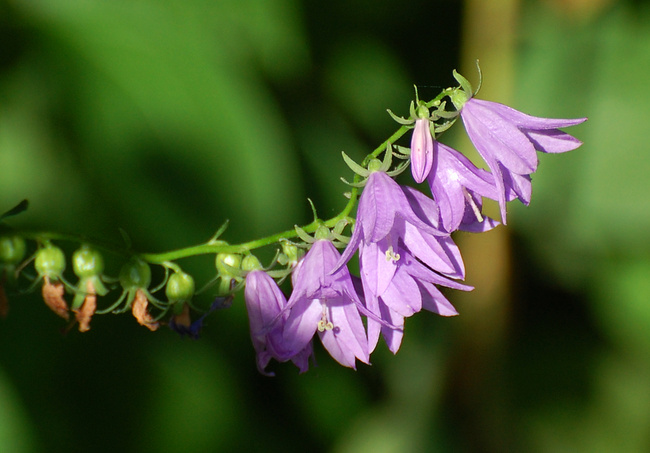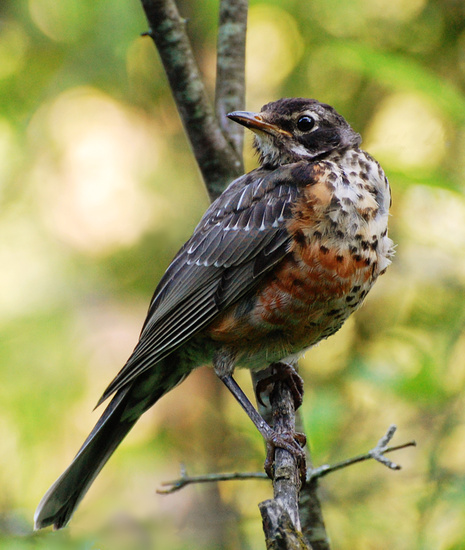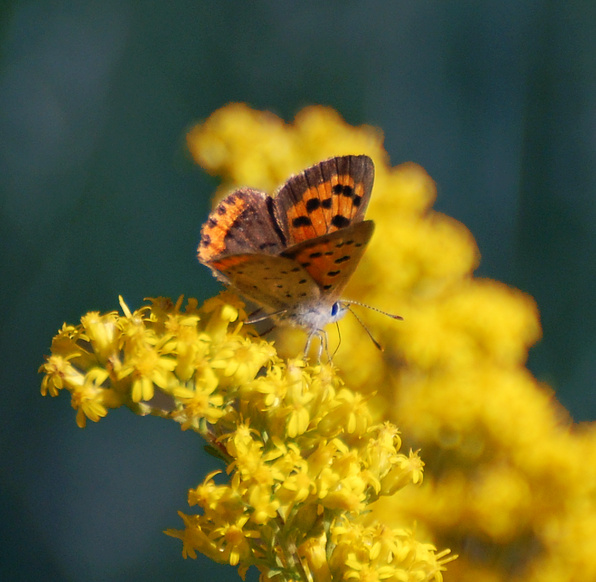
Ruby-Crowned Kinglet, Common Grackle with snack
September 17th, 2009


1680x1050 wallpaper
King Of The Woods
September 16th, 2009
I took this while watching the grand territorial duel of a couple weeks ago.

1680x1050 wallpaper
"King of the Woods" is one of the many traditional nicknames for Pileated Woodpeckers. In this case the name is ironic since, as you know from the story, they were on a cultivated lawn with shade trees, not in the woods. That's why the lighting's so good :-)
A few late-summer wildflowers
September 15th, 2009

Creeping Bellflower, wallpaper available

Common Toadflax framed by Wild Yarrow
Toadflax is pretty when you see it, but not very photogenic. This is the best I've been able to do so far.
Young Robin
September 14th, 2009
Robins are spot-breasted as fledglings, evoking their kinship with the spotted thrushes. This one is starting to mature as the rusty-red breast comes in bit by bit.

Fear me!
September 13th, 2009

I found this young fledgling Cooper's Hawk at Mud Lake--presumably the offspring of the breeding pair in that forest. He was actually trying to cool off on an unseasonably hot day, but in this picture, he appears as if he's trying to look fierce and failing!
American Copper Butterfly
September 12th, 2009

Bugs 'n blooms
September 11th, 2009
Duck migration is officially on my radar: American Wigeons have arrived at Mud Lake! I am very fond of this bird, which I only ever see in the fall: its glittering green face stripe, squeaky-toy voice, and the winsome facial expression of the females. For now, they're too far away for my lens. Past experience says that in the coming weeks, they'll slowly realize that no one is going to hunt them at ML, and come closer to shore.
In the meantime, here's a selection of bugs 'n blooms I've photographed recently.

1680x1050 wallpaper
A bumblebee gathering pollen from Spotted Knapweed. Photographed at Fletcher Wildlife Garden.

The beetle is called a Pennsylvania Leatherwing, aka Goldenrod Soldier Beetle. As per the second name, they have a pronounced fondness for goldenrod, but this one is making do with the next best thing: tansy. There's a spray of these pretty though odiferous wildflowers along one of the paths from Hurdman station to the river.

New England Asters, plus, I think, some variety of sweat bee. This is one of my favorite wildflowers. I look forward to them each year when August comes around. They're blooming everywhere now.
The Fisherman
September 10th, 2009
This very tame juvenile Black-Crowned Night Heron was fishing at the corner of Mud Lake yesterday. When I arrived, I joined a bevy of six or so people with binoculars, tripods, cameras, and some lenses that looked like they belonged in astronomical observatories. The heron remained indifferent to it all and went on about his business.

1680x1050 wallpaper

1680x1050 wallpaper
The Dance of the Pileated Woodpeckers
September 4th, 2009
So you think the oriole was neat?
You think Mud Lake pulled something pretty strange on me that day?
You ain't seen nothin' yet.
I first saw it walking down the road along the north shore of the lake. A big bird--no, two big birds--hopping around on the lawn of the filtration plant. Their stiff, exaggerated mannerisms put me in mind of Pileated Woodpeckers. I got closer and saw that they were indeed Pileated Woodpeckers: those magnificent, crow-sized woodpeckers with bright red crests. I've seen them many times, but each new sighting is a thrill.
That was the first surprise. Just that they were there. I've never seen nor heard Pileated Woodpeckers in that part of the conservation area. It's just not their habitat. They're deep-woods birds, not manicured-lawn birds!
I got up close and started photographing them, and was soon joined by a second photographer. The birds were very active, yet they didn't seem to be accomplishing anything. They just kept hopping around, posturing. It went on and on. And finally I realized they must be courting each other--even in September, they must be courting, or doing some sort of pair-bonding ritual in an already-existing relationship. There was no other explanation for such strange behavior, other than perhaps the presence of a powerful mood-altering drug. It was more than play. It was too earnest, too stereotyped, too, well, feverish to be merely play.
It was like a dance. He turned this way, she turned that way. They touched bills. They hopped up on a tree trunk together and played hide-and-seek. They pecked at things, but only in a way that seemed to say, "watch me peck wood!" "No, watch me peck wood!"
I've long known Ottawa Pileateds to be unusually tame, but this was a new record. They did all this in full view of two photographers, and eventually other onlookers; none of us were that far away. After awhile of it, one of them--I presumed the male--hopped away from the tree and started up a mating call. It was that loud, maniacal-laughter-type call that Pileateds do. Over and over again, non-stop, for minutes, "cuk cuk cuk cuk cuk!" Hopping and waving his bill with every "cuk." He got so into it, he hopped right off the lawn and into the road, still cuk-ing. I was beginning to seriously suspect that these birds were on something. Something good. Spanish fly for avians.
A utility vehicle drove by, and even that didn't phase them. Bless his heart, the driver slowed to a crawl to avoid hitting the bird that was still in the road. I thought I heard the driver make a "Woody Woodpecker" laugh. (Which pleased me. Woody Woodpecker was in fact modelled on Pileated Woodpeckers.)
Then one of them flew to another tree, and the other followed, and the dance continued awhile. And finally they flew off together into the distance. The other photographer and I looked at each other, and we both agreed: wow, that was really something. Yes, they must have been courting. What else?
When I arrived home, I loaded the memory card and looked through the 60+ pictures I had taken. That's when the punchline was delivered.
They were both male.



1680x1050 wallpaper

1680x1050 wallpaper

( More )
Once I saw that telltale red cheek stripe on both birds, everything took on new meaning: it was an epic territorial battle, with each male trying to out-peck, out-posture, out-voice, and generally out-woodpecker the other to prove he had the rights to Mud Lake. It seems obvious now. Although I will confess some sentimental attachment to my original impression of things: that it was the most unusual avian courtship I had ever seen!
A flame-red mystery bird
September 2nd, 2009
The birding at Mud Lake yesterday morning can only be described as "epic." 41 species, 10 of which were migrant warblers.
( Bird geeks click here )
The most exciting part of the day was also the single most frustrating part of the day. In the swampy woods near the filtration plant, a strange bird briefly appeared in the treetops to the west (at the edge of the swamp). It appeared so briefly, and was so unclassifiable, that it soon became difficult to trust my memories of it. By evening, all I had left that I was sure of was, "it was red. It was red, by god, it was red, and it was a red that wasn't kidding around!" I mean, there aren't many red birds in North America. You'd think that would make it easy!
It was vivid red, and I could have sworn it had wing bars. Problem: there is no such thing as a "vivid red bird with wing bars" in this part of the world. My first thought was White-Winged Crossbill. But Crossbills are dingy, greyish red. This was more like flame red.
I talked to the guide of the large group, and he didn't have any ideas, other than one that had already occurred to me: it was a molting male Scarlet Tanager, whose strange molt-pattern conspired to convince me that I saw wing bars. I also thought of Western Tanager--a tanager with wing bars native to the western states and provinces--but it only has a red head.
When I got home, I checked my full Peterson's: the guide that covers all North America. There was one bird in there that matched what I thought I had seen. It's called a Flame-Colored Tanager. But that's ludicrous. Flame-Colored Tanagers are already highly rare in south Texas and Arizona, where they occasionally wander in from Mexico.
Whatever it was, I figured, there was no way I'd ever be sure, unless someone else got a better look at it and sent in a report. I filed it in my records as a "maybe Scarlet Tanager", reported it to the OFNC as a "looked like a Flame-Colored Tanager, but please don't tell people I said that, I don't want to be a laughingstock," and pouted.
The next morning, I had email from Chris Lewis of the OFNC. This story has a happy ending. It wasn't a rare species I saw, but it was definitely a rare bird!
From: Christina LewisHere's the article.
To: Suzanne Britton
Subject: Re: Mud Lake birding, Sept 1st
Date: Wed, 2 Sep 2009 07:31:51 -0400
Hi Suzanne,
Thanks for the report. I & others also saw lots of warblers (total of 16 species) on the 30th - nice to hear that some of them were still around yesterday.
That weird red bird at Mud Lake is - believe it or not - a BALTIMORE ORIOLE! Several people (including myself) saw it on Sunday and we really scratched our heads over it for a while but after getting good looks at it, especially the bill shape, wing bars and general size & structure of the bird we realized that's what it was. Further investigation revealed that this odd pigmentation has been noted in Baltimore Orioles and other spp. that feed on honeysuckle berries; Cedar Waxwings can develop orange (rather than yellow) tips on their tails due to a chemical called rhodoxanthin which is found in these berries. An interesting article about this phenomenon is presented in ABA Birding 2007 - you can read it online (google "baltimore oriole red plumage" and look for the ABA link). Apparently such a bird seen in Halifax in 2005 was also misidentified as a Flame-coloured Tanager!
Good birding,
Chris
|
